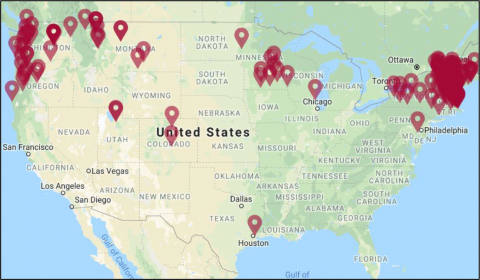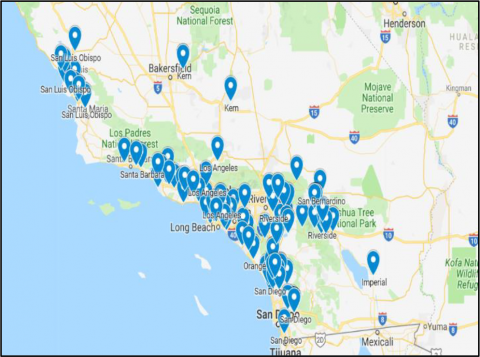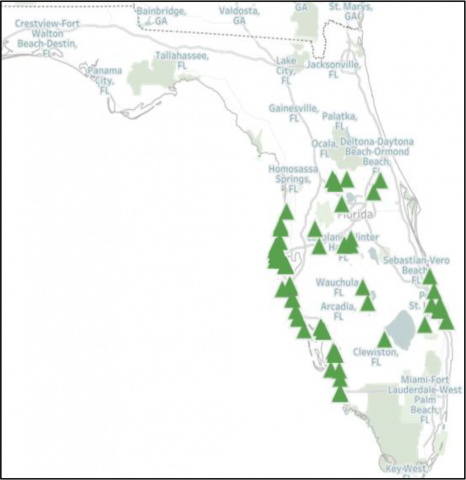Manufactured housing is gaining recognition as an important source of affordable housing and many of these homes are located in Manufactured Housing Communities (MHC). While ownership of MHC can take many forms, under Duty to Serve, Fannie Mae and Freddie Mac are working to help increase liquidity for non-traditional owners. Non-traditional owners include governmental entities, non-profit organizations, and resident-owned communities. Preliminary estimates show that there are currently 800 non-traditionally owned MHC. According to DataComp/JLT, a third-party data vendor specializing in MHC, the vast majority of these are resident-owned communities. These communities can be found in almost every state and are located in rural, suburban, and even metropolitan areas. In some cases, MHC can consist of more than 300 homes.
Resident-Owned Communities Provide Stability
Part of what makes MHC more affordable is residents only have to purchase their home; they do not have to purchase the land on which their home sits. Instead they rent lots – known as pads – as well as any utility hookups from the MHC. However, when the pad rents rise too quickly or the MHC is sold and the new owner raises pad rents significantly, this affordable housing can quickly become less affordable. While a homeowner could theoretically move their mobile home to a community with lower pad rents, in reality, it can be quite costly – as much as $5,000 – to move the home, and moving can potentially damage the home. As a result, resident-owned communities are quickly gaining popularity, and often give residents an opportunity to better manage and control MHC costs.
A Large Network of Resident-Owned Communities
The leading group of resident-owned communities is ROC USA. Created in 2008, ROC USA is a non-profit that helps residents purchase their manufactured housing communities through a network of nine affiliated entities, including Casa of Oregon in the western region of the U.S.; the Cooperative Development Institute in the eastern region; and North Country Cooperative Foundation in the upper Midwest.

In the ROC USA model, homeowners form a non-profit cooperative. Each household is a member of the cooperative, which owns the land and manages the business of the MHC. Members continue to own their own homes individually in addition to an equal share of the land beneath the entire community. The benefits of living in a resident-owned community include greater tenant control of monthly pad rent, community repairs, and improvements. As a result, many resident-owned MHCs have a strong sense of community, are well maintained, and have inherent protections regarding eviction.
ROC USA MHC in 15 States
As the map demonstrates, ROC USA has a vast group of resident-owned MHCs. Its affiliates work with more than 200 resident-owned MHCs in 15 states coast to coast. In fact, residents in more than 25 MHCs have purchased their parks and converted them into resident-owned communities in past 18 months alone.
Many MHC in Northeast
While MHCs are frequently associated with warmer southern states like Florida and Arizona, about half of the MHCs in the ROC USA network are located in the Northeast, where housing costs tend to be among the most expensive. Some of the largest ROC USA MHCs are also located in the Northeast. For example, Halifax Estates, located about an hour south of Boston, is the largest ROC USA MHC, with an estimated 430 homes. It is restricted to residents aged 55 and older. There are another 35 ROC USA MHCs in the northeast that consist of 100 or more homes.
Resident-owned Parks, Inc. Also Helps Convert MHCs
Information is more limited about resident-owned MHCs outside of the ROC USA network. However, there appear to be a significant number in California. For instance, Resident-owned Parks, Inc., a non-profit housing corporation and consulting firm, has converted eight MHCs in California into resident-owned communities, preserving 617 homes. Even smaller MHCs are going the resident-owned community route. One interesting example was the recent conversion of the Blue Spruce Mobile Home Lodge MHC located in the wine country of Sonoma County. Surrounded by vineyards, Blue Spruce has 54 homes located outside Santa Rosa.
A Significant Number of Resident-owned MHCs in California

Based on self-reported data, there appear to be an estimated 200 resident-owned MHCs in California, representing more than 30,000 homes. There appear be a higher concentration in Southern California, particularly in and around Los Angeles. Over half of these resident-owned MHCs are age-restricted.
Four out of the top five largest resident-owned MHCs are located in Riverside County and are age restricted to 55 years and older. The largest resident-owned MHC, with more than 1,900 homes, is Palm Desert Greens, followed by Tri-Palms Estates with more than 1,600 homes. Sierra Dawn Estates rounds out the top three resident-owned MHCs with more than 1,500 units.
A Few California Counties Have A High Concentration of MHCs
Several counties in California appear to have an especially high number of resident-owned MHCs. Both San Diego and Riverside counties appear to have over 30 each. Santa Cruz has more than 20 and Orange and San Luis Obispo each have over 10 resident-owned MHCs. The counties with a higher concentration of non-age-restricted resident-owned MHCs – more than 10 each – are San Diego, Los Angeles, and Santa Cruz.
Florida Has its Own Resident-owned MHC Association

Florida Resident-owned Communities, Inc., a not-for-profit corporation with nearly 120 resident-owned MHCs, supports and assists resident-owned MHCs throughout Florida. As shown in the map to the left, most of these resident-owned MHCs are primarily located in central and south Florida.
A Few Florida Counties Have A High Concentration of MHCs
While many Florida cities have just one resident-owned MHC, a few have several. St. Petersburg and Largo have over 10 each. Fort Myers, Bradenton, and Naples each have more than five. Among others, Clearwater and Punta Gorda have four each, and Sarasota and Pinellas Park each have three resident-owned MHCs.
Ownership Can Take Many Forms
Resident-owned MHCs in Florida are not limited to just a cooperative structure – many are condos. Under this model residents own both their home and land, giving them more independence. However, associated costs tend to be higher.
Most States Have At Least One ROC
According to Datacomp/JLT, three states contain over 2/3 of all resident-owned communities: California, Florida, and New Hampshire. Massachusetts also has a significant number of communities with 35. Eight more states have between 10 and 20 communities. In all, 37 states have at least one resident-owned community according to Datacomp.
Select Resident-Owned MHCs by State
| State | Number of ROC |
|---|---|
| California | 213 |
| Florida | 177 |
| New Hampshire | 129 |
| Massachusetts | 35 |
| Oregon | 18 |
| Washington | 16 |
| New York | 15 |
| Arizona | 14 |
| Minnesota | 12 |
| Vermont | 12 |
| Texas | 11 |
| Montana | 10 |
Southwest Contains a Few ROC
There are ROC scattered throughout the Southwest. Arizona and Texas have the highest concentration with 14 and 11 resident-owned communities respectively, according to Datacomp. In Texas, Hidalgo County appears to have the highest concentration. For instance, the Adobe Wells retirement community in McAllen has about 300 homes. The rest of the communities are scattered throughout the Texas.
Non-Profits Taking Another Look at MHCs
While non-profits have generally bypassed MHCs in favor of traditional apartment buildings in the past, many are giving MHCs a second look. Non-profit ownership can be useful where residents have no experience or desire to run an MHC, leaving the non-profit responsible for managing the community.
Several non-profits target MHCs specifically. As shown in the table below, one of the non-profits with the largest portfolio of MHCs is the Millennium Housing Corporation. According to Millennium, it currently has 19 MHCs located in California which serve 4,500 households with more than 10,000 residents in total. Augusta Communities is another non-profit that has six MHCs in California, serving 925 households with about 2,500 residents.
Oregon Addressing MHCs Built Prior to 1976
While St. Vincent DePaul of Lane County in Oregon has a portfolio of primarily affordable multifamily properties, it has also been targeting MHCs through its Mobile Home Park Reclamation initiative. According to St. Vincent DePaul, there are currently about 40,000 units of manufactured housing in Oregon that were built prior to 1976. That year, the U.S. Department of Housing and Urban Development (HUD) instituted industry standards for manufactured housing. To date, St. Vincent DePaul has been focused on these MHCs, thereby helping preserve housing affordability in seven MHCs, representing a total of 251 households. The non-profit has also recently purchased an additional MHC with 130 households, with the goal of replacing the pre-1976 homes with new homes while preserving the community’s affordability.
Non-Profit Entities with Multiple MHCs
| Non-Profit | MHC Owned/Sites | MHC Acquisitions ($M) (to date) | State |
|---|---|---|---|
| Millennium Housing Corporation | 19/4,500 | $53.5 | California |
| Caritas Corporation | 15/3,900 | $64.7 | California |
| St. Vincent DePaul Society of Lane County | 7/251 | N/A | Oregon |
| Augusta Communities | 6/925 | N/A | California |
| Manufactured Housing Community Preservationists | 5/342 | N/A | Washington |
NeighborWorks Affiliates Also Assist MHCs
NeighborWorks America is a nationwide non-profit promoting affordable housing through a network of affiliates that either help owners or own MHCs outright. NeighborWorks has focused on the MHC sector to help preserve affordable housing in many rural areas, and is focusing particularly on MHCs built prior to 1976.
Government Entities Also Involved
In some jurisdictions, state and local public housing authorities own and operate MHCs. Local government can also acquire MHCs through a relationship with a support organization. In some cases, non-profits and government agencies intervene when closure or substandard conditions threaten the ongoing viability of an MHC. In that way, these entities can end up becoming owners.
Currently, there is a backlog of deferred maintenance for many public housing properties, and MHCs are unfortunately no exception. While HUD’s Rental Assistance Demonstration program can help refinance some of these properties, the program is limited by a finite amount of funds and must also assist apartment properties that are owned by state and local public housing authorities. As a result, additional sources of financing are needed to keep MHCs owned by public housing authorities affordable and in good repair.
Some Entities Own Multiple MHCs
While many government entities own a single MHC, some own several. As shown in the table below, two of the government entities with multiple MHCs are located in Washington state. The King County Housing Authority owns five such MHCs that can house up to a total of 651 households. The Housing Authority of Snohomish County owns five MHCs that can house up to 183 households. In addition to providing affordable rental housing, both counties offer programs for affordable homeownership at their MHCs.
Government Entities with Multiple MHCs
| Government Entity | MHC Owned/Sites | MHC Sites | State |
|---|---|---|---|
| Housing Authority of Snohomish County | 3 | 183 | Washington |
| King County Housing Authority | 5 | 651 | Washington |
An Ongoing Trend in the Need for Non-Traditional MHC Ownership
MHCs are a solid and reliable source of affordable housing for both homeowners and renters in many places across the country, in both suburban and rural locations. Unfortunately, the number of MHCs is declining. In suburban areas, MHCs are in danger of being replaced by either traditional apartment buildings or other commercial properties. In some rural areas, many MHCs are older and in need of upgrades and renovations. In these cases, a non-traditional or non-profit ownership structure can be particularly useful.
The trend of non-traditional ownership has been expanding. For example, ROC USA saw an estimated 15 percent increase in conversions to resident-owned MHCs in just 18 months. Other non-profits and grassroots movements are forming to protect MHCs in various parts of the country. As a result, while still a small number, we believe the trend towards non-traditional ownership of MHCs is likely to continue over the next several years, especially as housing affordability remains a concern for many households.
Tanya Zahalak
Senior Multifamily Economist
Multifamily Economics and Market Research
May 2019
Opinions, analyses, estimates, forecasts and other views of Fannie Mae's Multifamily Economics and Market Research Group (MRG) included in these materials should not be construed as indicating Fannie Mae's business prospects or expected results, are based on a number of assumptions, and are subject to change without notice. How this information affects Fannie Mae will depend on many factors. Although the MRG bases its opinions, analyses, estimates, forecasts and other views on information it considers reliable, it does not guarantee that the information provided in these materials is accurate, current or suitable for any particular purpose. Changes in the assumptions or the information underlying these views could produce materially different results. The analyses, opinions, estimates, forecasts and other views published by the MRG represent the views of that group as of the date indicated and do not necessarily represent the views of Fannie Mae or its management.
